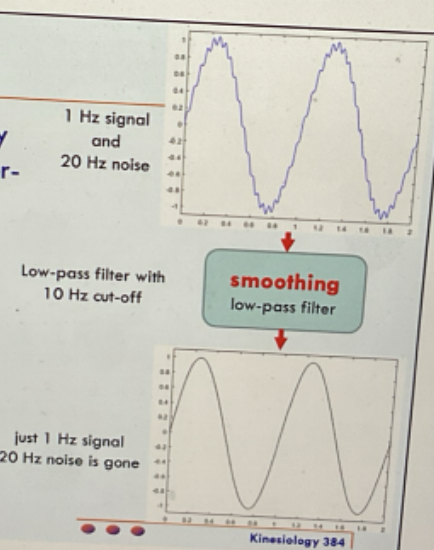Kinesiology 384
1/70
Earn XP
Description and Tags
3rd exam
Name | Mastery | Learn | Test | Matching | Spaced |
|---|
No study sessions yet.
71 Terms
what are impacts
large force applied over time
occurs when bodies collide
could produce a rapid change in velocity in one or both bodies
what happens to KE in an impact that has implications for injury?
lost KE goes into the deformation of colliding bodies
what is the relationship between collisions and momentum?
the net external impulse acting on a “system” of bodies determines change in system’s momentum
with no net external forces, momentum will not change (it is “conserved”)
what are the 2 types of collisions?
perfectly elastic collision
perfectly inelastic collision
what is a perfectly elastic collision?
when bodies bounce off one another
no energy is lost
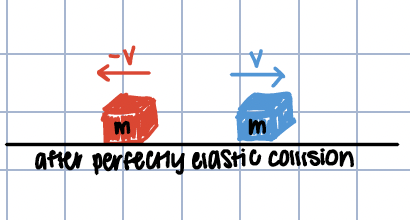
what is a perfectly inelastic collision?
bodies stick together
energy is lost
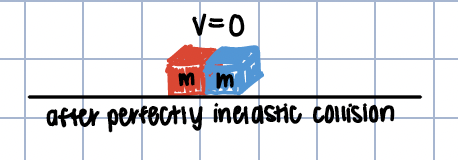
what is the coefficient of restitution?
e, is an indication of how elastic/inelastic the collision is
e is a property of a collision that depends on materials, temperature
what is the coefficient of restitution for a perfectly elastic collision? what about for a perfectly inelastic collision?
perfectly elastic collision: e=1.0
perfectly inelastic collision: e=0
what is e also defined by?
it is defined by the ratio of relative velocity after (rebound velocity) to relative velocity before (approach velocity)
e = (v’b - v’a) / (va - vb)
what is conservation of momentum?
the momentum of a system remains constant before, during, and after a collision
ONLYYY if the next external force acting on the system is 0
for 2 bodies a and b
mava + mbvb = m’am’v + m’bv’b
whether a collision is elastic or inelastic doesn’t affect whether momentum of a system is conserved

what is the conservation of energy?
the energy of a system may remain constant during a collision, but 2 conditions must be satisfied:
no work is done on the system by external forces
the collision must be perfectly elastic (e=1.0)
forces associated with elastic collisions are conservative (spring-like)
ex: rubber balls, billard balls
forces associated with inelastic collisions are non-conservative (“plastically” deforming)
ex: clay, bean bags
an image that describes the conservation of energy
image of conservation of energy
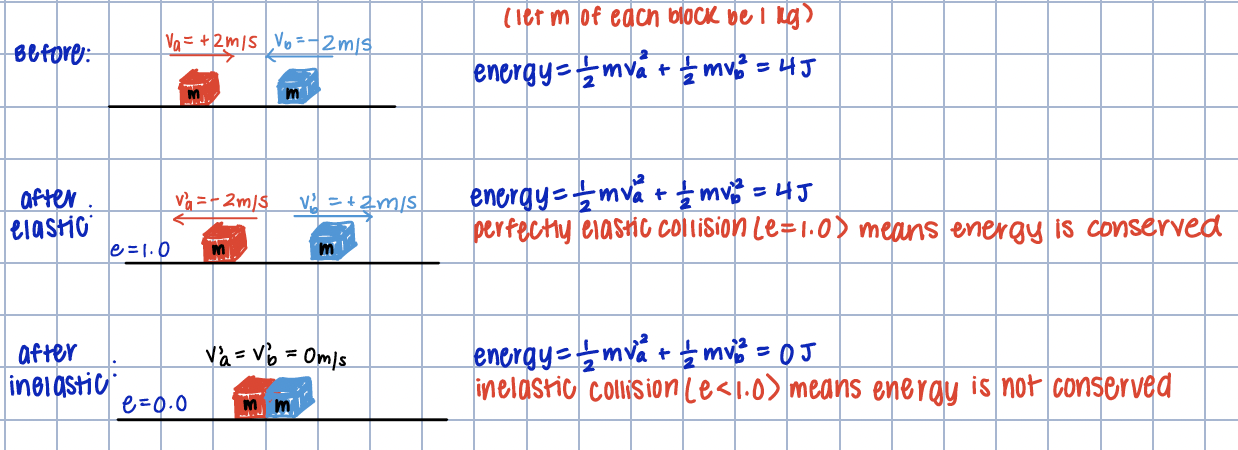
what does a fluid do compared to a solid?
a fluid continuously deforms in response to applied shearing (parallel to surface)
push sideways on a deck of cards and it behaves like a fluid
glue all cards together and it behaves like a solid
why is air considered a fluid?
both gases and liquids are fluids, except air is compressible and water is not
called hydrostatic pressure
what is hydrostatic pressure?
pressure squeezing bodies that are underwater
increases with depth of water
squeezing is the same in all directions
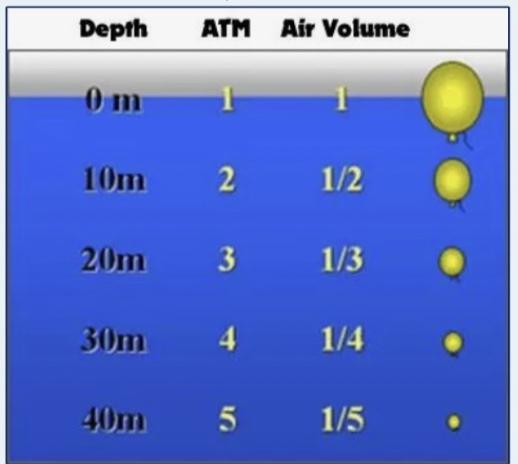
what is pressure?
pressure is the force acting evenly over an area
pressure = force / area
units: Pascal (Pa) 1 Pa = 1 N/m²
what is density and how does it relate to hydrostatic pressure?
density is the mass per unit volume
hydrostatic pressure is due to the weight of water above the submerged body
depends on depth, density, and gravity
p = pgh
h = depth of water
p = density of fluid kg/m³

what is the density of pure water?
1000 kg/m³
what is buoyancy?
your body floats in water because of the buoyant force
buoyant force: upward force that acts on a submerged or partially submerged body
buoyant force is due to a pressure difference
essentially it works because: weight of the air you displace << weight of the water you displace

how does one know a body will float?
every submerged body has a buoyant force acting on it; some float and some don’t
body floats if buoyant force (weight of displaced fluid) is equal to weight of body ….
Fnet = FB - W = 0
if FB < W, body accelerates downward (sinks)
if FB > W, body accelerates upward until just enough body is submerged to make Fnet = 0
floating depends on densities (equation in image)

what is the center of volume?
the buoyant force acts at the body’s center of volume…RECALL that body weight acts at body’s center of mass
COV → where COM would be if body had same density everywhere
human body COV is above COM
buoyant force and weight produces rotation of the body until COM is directly under COV
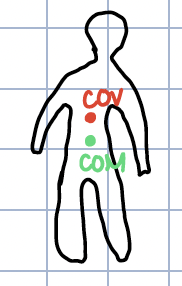
what is a drag force?
drag force → a force that resists motion through a fluid (equation provided in image)
drag force acts in backward direction

what is the measurement of CdA in the equation for drag force?
product of CdA depends on moving body’s size and shape
normal time-trial position CdA = 0.254m²
superman position CdA = 0.150m²
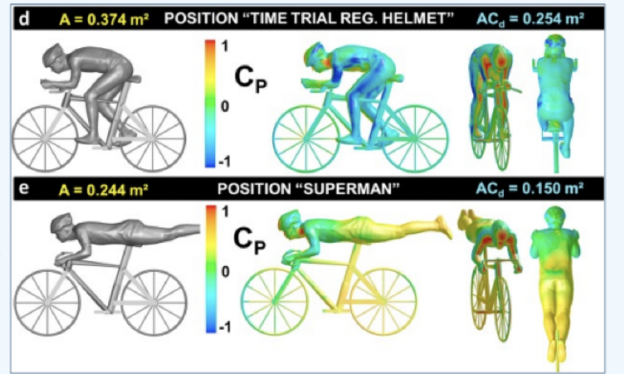
what is terminal velocity?
a falling object keeps falling faster and faster in a vacuum (no air)
downward a = 9.81m/s²
in air, drag force increases with velocity
upward drag force slows falling until equilibrium is reached: W = Fdrag
with no net vertical force, vertical velocity is constant
this final velocity is called “terminal velocity”
what is the “loudest injury in sport”?
the rupture of the achilles tendon
what is the relationship between forces and injury?
kinetic analysis (basically F=ma) can tell us how the forces applied to bones, tendons, and ligaments may have differed
however, forces are not the whole story
what is stress?
stress is the amount of tissue deformation caused by a force; depends on the tissue size
stress is force divided by the area over which the force is distributed
units: N/m², or pascal (Pa)
there is normal stress and shear stress

what is normal stress?
force applied normal to face
equation in image

what is shear stress?
force parallel to face
equation in image

what is a linear strain?
is change in length divided by the original (unstretched) length: Ɛ = (L - Lo)/Lo
when Ɛ = 0.02, length has changed by 2%

what is a shear strain?
is the change in shape, given by an angle expressed in radians: γ = theta - thetao
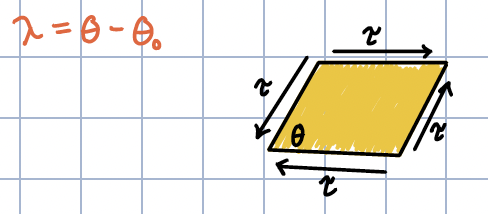
what different ways can forces, moments, and torques be applied to a body?
bending → compressive normal stress; tensile normal stress; and shear stress
tension → tensile normal stress
torsion → shear stress
compression → compressive normal stress
what is elastic vs. plastic material?
elastic → describes a material that shapes back to its original shape when unloaded
plastic → describes a material that has yielded
i.e. been loaded past the point when elastic behavior is no longer possible
return to a shape that is different from the original shape
what is the stress-strain curve?
stress plotted on y-axis
linearly elastic materials have a linear curve
look at image
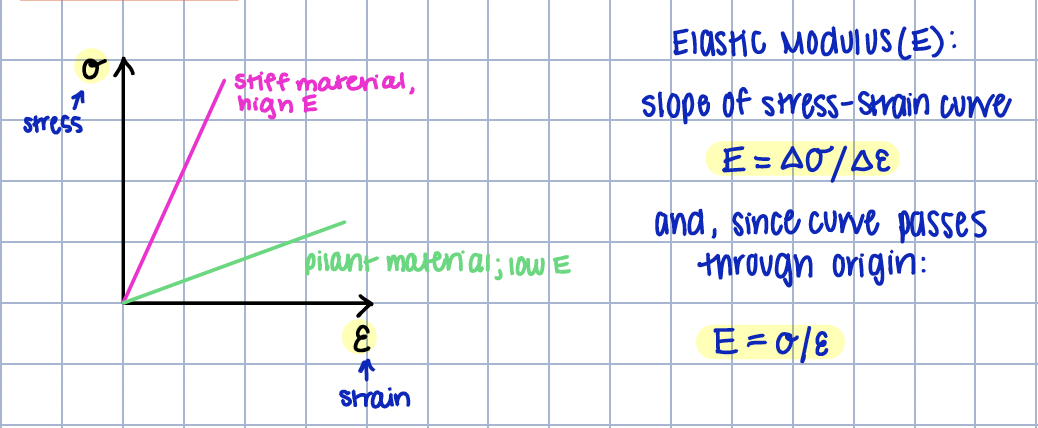
what are elastic moduli for biomaterials?
stiffer biomaterials have higher E
cortical bone: E = 15GPa
trabecular bone (spongey):
young human spine: E = 60MPa
osteoporotic: E = 30MPa
achilles tendon: E = 600 MPa
ACL: E = 500MPa
cartilage: E = 10MPa
how is strength (which is determined by stress at failure) measured?
determined using material testing
stress and strain measured
yield strength, ultimate strength, failure strength
what is yield strength?
apply this much stress and material will not return to undeformed shape
what is ultimate strength?
the most stress a material can carry
what is failure strength?
stress at which material finally ruptures
physiological tendon loading
look at image
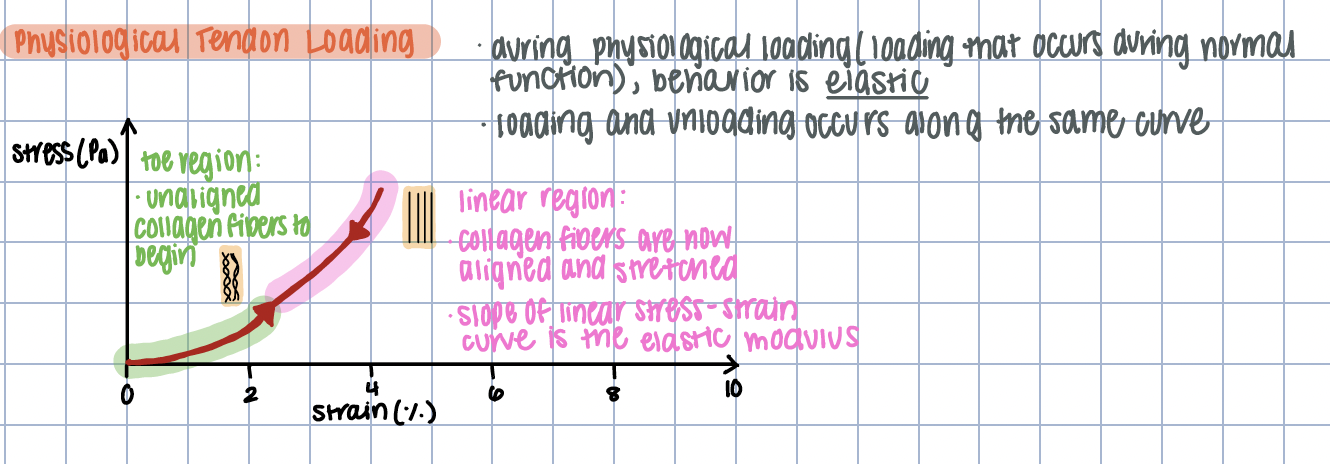
what are the forms of motion analysis?
2-dimensional
makes 2 markers per segment
one camera
3-dimensional
3 markers per segment (not in a line)
multiple cameras
either 2D or 3D may be manual or automated
manual when human identifies markers
automated when computer does this
what is reconstruction?
actual (x,y,z) coordinates of points (look at image)
we say that the actual coordinates (3D x,y,z) are “reconstructed” from image coordinates obtained from each camera
involves solving systems of ray equations
finding the intersection of several rays, one for each camera
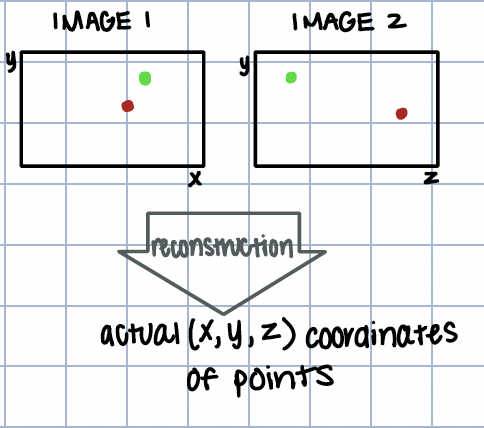
how does 3D motion analysis work?
each camera sees only one 2D image
depth cannot be judged by a single camera
look at image
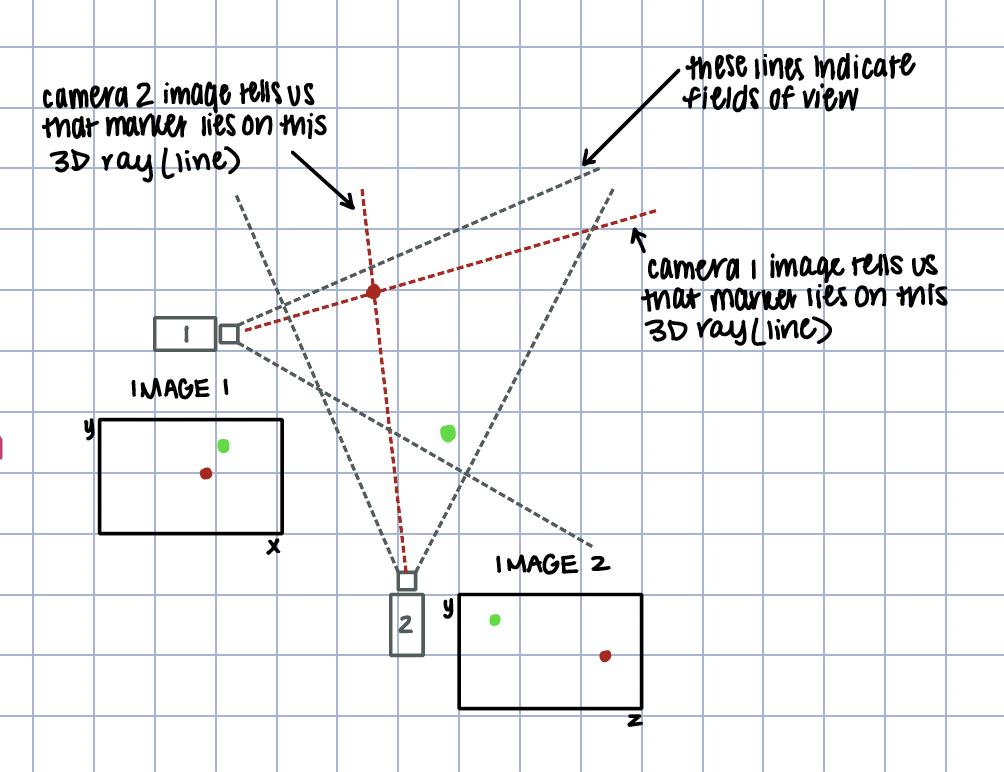
how does calibration in 3D motion analysis work?
system initially does not know
where cameras are
in which directions cameras point
calibration produces this information
results in relationships for operating ray equations from 2D image coordinates

what is a cheap force plate?
actually reads extension of spring inside scale
force converted to displacement
depends on Hooke’s law: F = kx
makes one measurement of vertical ground reaction force (GRF)
doesn’t locate center of pressure
How do force plates work?
strain gauges located on supports at each corner
force plate supports deform when foot is on plate
deformation at corners directly related to force applied
Hooke’s Law, F= kx
electrical resistance of strain gauge is measured

what is a strain gauge?
they are transducers whose electrical properties change when they are stretched
how?
current flows less readily through wires that have been stretched
strain gauge: a small wire glued to something whose deformation we want to monitor
how do you find the “center of pressure”?
COP → point at which GRF would act if GRF acted at a single point
use of multiple strain gauges gives information about the location of the COP: (look at image)

How do you calculate COP in a 2D example?
look at image!!
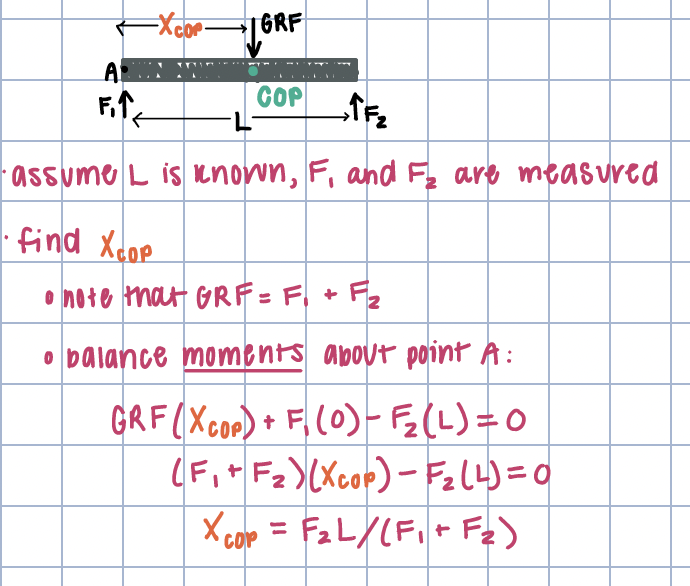
what is a wearable sensor?
smartphones and fitness trackers contain several useful for measuring activity and tracking progress
apple, xiaomi, fitbit, etc
information from multiple sensors integrated to measure motion
whats inside a wearable sensor?
accelerometer
gyroscope sensor
magnetometer
GPS receiver
what is an accelerometer?
tiny microelectromechanical systems (MEMS) device
essentially a mass attached to the case by a spring
change in spring length is proportional to acceleration: F = ma → k(x - xo) = ma
useful for step counters, estimating metabolic energy expenditure, identifying activiting (driving, etc)
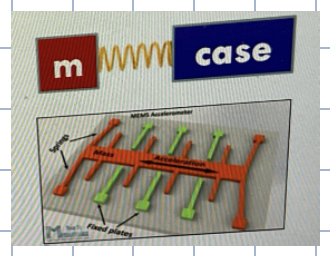
what is a gyroscope sensor?
MEMS device that makes use of Coriolis effect to sense angular velocity
provides improved exercise identification in a Fitbit (e.g. detecting sleep)
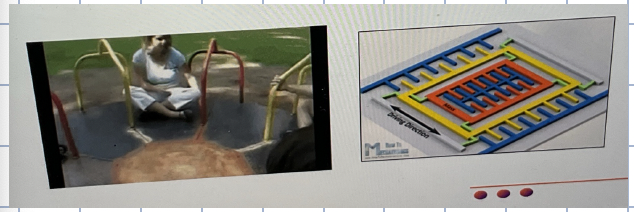
what is a magnetometer?
earth generates a magnetic field with lines of flux that run from magnetic South to magnetic North
a magnet placed in this field experiences forces that make it align with these lines
magnetometer determines orientation and heading during navigation or tracking activities (e.g. running, cycling)
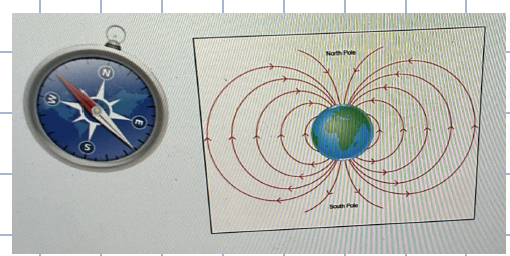
what is a GPS receiver?
satellites carrying very stable clocks continually sending out radio time signals
GPS receiver recevies multiple signals, uses the speed of the radio signal (the speed of light) to find distances from satellites
if 4 distances are known, the 3D position of the receiver may be found
latitude, longitude, altitude
useful for logging routes, mileage, and for estimating pace
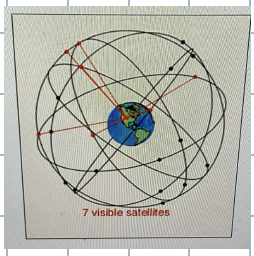
what does validity mean?
measures are valid if they measure what they are designed to measure
validity is relative
people often want to know if a test or measure has been “validated”
no test is perfectly valid
better to discuss how valid a test is rather than whether it is valid
what is reliability?
a test is reliable if it gives consistent results
what are the different forms of reliability?
inter-rater reliability and test-retest reliability
what is inter-rater reliability?
measurements made at the same time
what is test-retest reliability?
measurements made at different times
what is the relationship between accuracy and precision?
accuracy:
Refers to how close a measured value is to the true or accepted value.
If a measurement is accurate, it means it is close to the correct or standard value.
precision:
Refers to how consistent or repeatable measurements are when repeated under the same conditions.
If a set of measurements are precise, they are very close to each other, regardless of whether they are close to the true value.
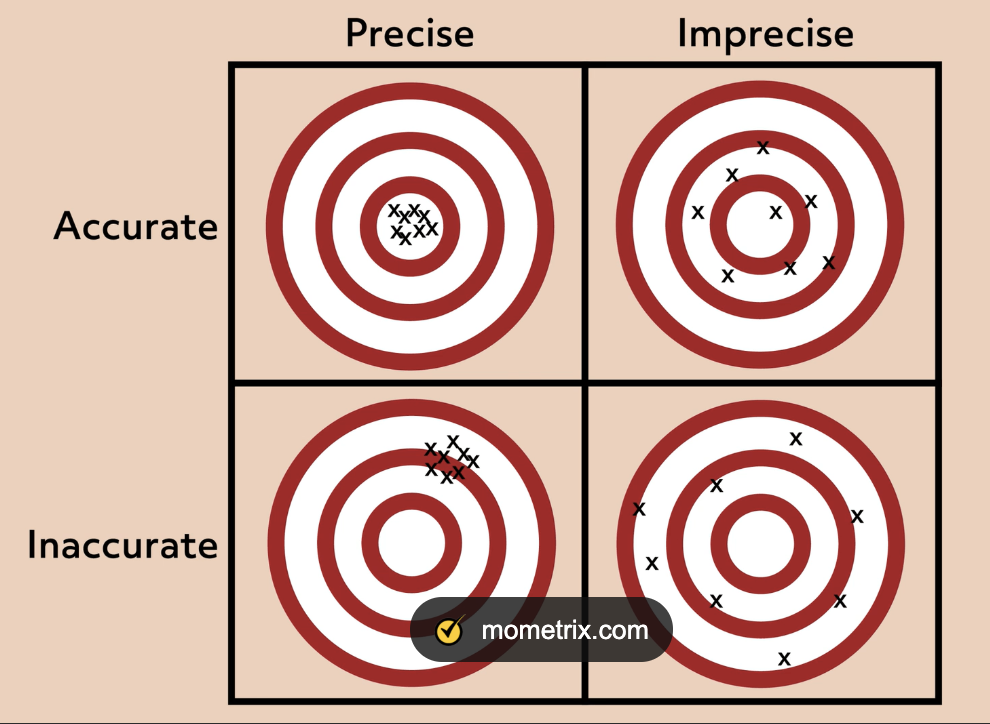
what is sampling frequency?
sampling frequency (fsamp): rate at which data are sampled
aka “sampling rate”
measured in samples per second, or hertz (Hz)
what happens if fsamp is too low?
aliasing will occur
a signal can appear to be a different signal (have an “alias”) when sampled too slowly
how to choose a sampling frequency?
sampling faster is better, but sometimes sampling rate is limited
by available data storage
by sensor/sampling technology
minimum sampling rate
at least 2x the frequency of the signal you care about
depends on the question you want to answer
what are the 2 measurement errors?
systemic error
random error
what is systemic error?
affects repeated measurements in the same way
every data point is “off” by the same amount
what is random error?
varies unpredictably with each measurement
also called “noise”
as opposed to “signal” (data of interest)
what problems can occur due to random errors in position data?
errors in position may be small, but we often need velocities or accelerations
velocity and acceleration computed from position are sensitive to position noise

what is the signal and noise relationship?
look at image

what is data smoothing?
“smoothing”: eliminates high-frequency (rapidly changing) noise, leaving lower frequency (slower changing) signal
what is a low-pass filter?
low pass filter:
saves (lets pass) low-frequency signal
discards high-frequency noise
cut-off frequency separates the two
typically 5Hz for motion data
typically 45Hz for force data
